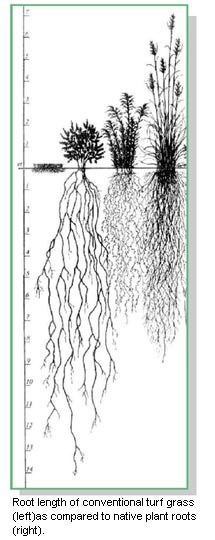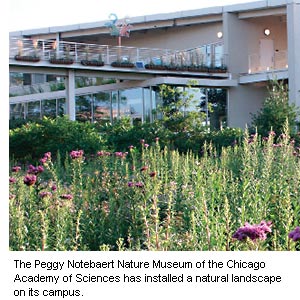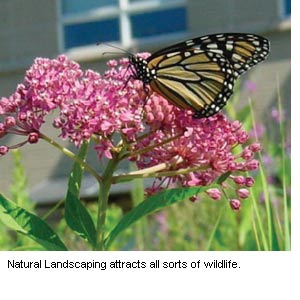 |
Natural landscaping refers to the use of native vegetation – particularly prairie, wetland and woodland species – on a development or redevelopment site. Native vegetation is a low-cost alternative to traditional landscaping that utilizes turf grass and ornamental plantings.
A site that is naturally landscaped will produce substantially less stormwater runoff than a conventional landscape. Native vegetation enhances both absorption of rainfall and evaporation of soil moisture due to extensive root systems that extend down 3 to 10 feet or more. In contrast, the root zone of turf grass typically extends only about 3 to 4 inches. The benefits of natural landscaping are enhanced if runoff from impervious surfaces is routed across native vegetation buffer strips. A local residential site assessment indicated that annual storm runoff volumes from a residential development could be reduced by as much as 65 percent by utilizing swales and filter strips with native wet prairie and prairie vegetation. Similarly, natural landscaping reduces pollutants associated with urban runoff. In the residential site assessment, it was estimated that removal rates for suspended solids and heavy metals(such as cadmium and lead)could be as high as 80 percent and removal rates for nutrients (such as phosphorus and nitrogen)could be as high as 70 percent for a residential development utilizing natural drainage and native landscaped filter strips.
In addition to reducing stormwater runoff, natural landscaping provides a host of other benefits. Deep-rooted native plants effectively stabilize soils and prevent erosion along streambanks and detention basin edges. The reduced maintenance needs of natural landscaping not only save money, but also reduce air, water and noise pollution. Natural landscaping also provides habitat for native and migrating birds, butterflies, and insects. Natural landscapes, especially trees, also moderate temperature extremes (such as the “urban heat island” effect), resulting in reduced heating and air conditioning costs.
Finally, natural landscaping provides four seasons of color and textures not commonly found in conventional landscapes and requires less maintenance over time.
Applicability
Natural landscaping is feasible on nearly all sites as an alternative to conventional landscaping. It should be tailored to individual site characteristics, factoring in topography, soils, drainage patterns and sun exposure. On some sites natural landscaping can be installed or preserved in an informal setting; on others, native plants can be used in more formal settings in place of imported species. Suggested site applications include: river or wetland edges, detention basin and drainage features, parks, green roofs, residential areas and gardens, commercial, industrial and institutional developments
|



